Satas D., Tracton A.A. (ed.). Coatings Technology Handbook
Подождите немного. Документ загружается.

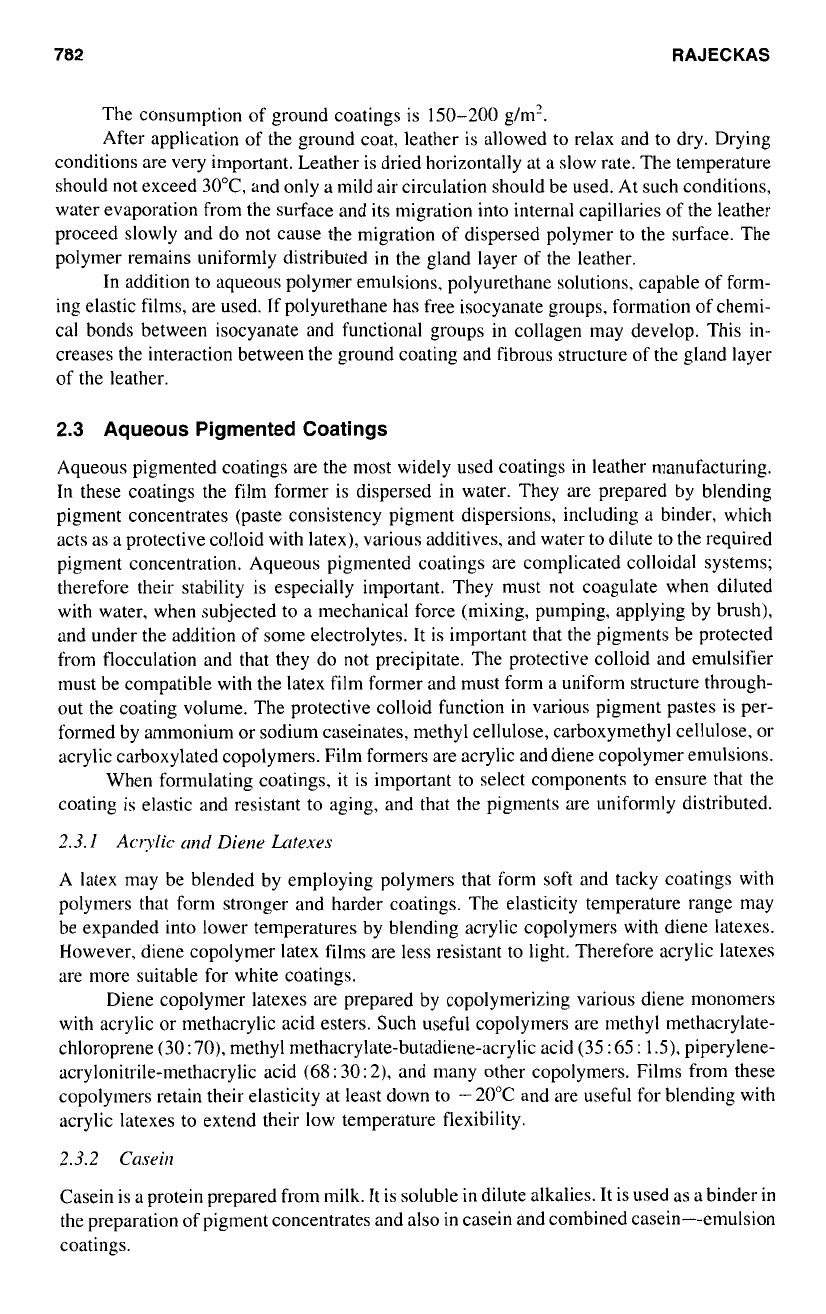
782
RAJECKAS
The consumption
of
ground coatings is 150-200 g/m'.
After application of the ground coat, leather is allowed to relax and to dry. Drying
conditions are very important. Leather is dried horizontally at a slow rate. The temperature
should not exceed 30"C, and only a mild air circulation should be used. At such conditions,
water evaporation from the surface and its migration into internal capillaries of the leather
proceed slowly and do not cause the migration
of
dispersed polymer to the surface. The
polymer remains uniformly distributed
in
the gland layer of the leather.
In addition to aqueous polymer emulsions, polyurethane solutions, capable of form-
ing elastic films, are used. If polyurethane has free isocyanate groups, formation of chemi-
cal bonds between isocyanate and functional groups in collagen may develop. This in-
creases the interaction between the ground coating and fibrous structure of the gland layer
of
the leather.
2.3 Aqueous Pigmented Coatings
Aqueous pigmented coatings are the most widely used coatings
in
leather manufacturing.
In these coatings the film former is dispersed in water. They are prepared by blending
pigment concentrates (paste consistency pigment dispersions, including
a
binder, which
acts as a protective colloid with latex), various additives, and water to dilute to the required
pigment concentration. Aqueous pigmented coatings are complicated colloidal systems;
therefore their stability is especially important. They must not coagulate when diluted
with water, when subjected
to
a mechanical force (mixing, pumping, applying by brush),
and under the addition of some electrolytes. It is important that the pigments be protected
from flocculation and that they do
not
precipitate. The protective colloid and emulsifier
must be compatible with the latex film former and must form
a
uniform structure through-
out the coating volume. The protective colloid function
in
various pigment pastes is per-
formed by ammonium or sodium caseinates, methyl cellulose, carboxymethyl cellulose, or
acrylic carboxylated copolymers. Film formers are acrylic and diene copolymer emulsions.
When formulating coatings,
it
is important to select components to ensure that the
coating
is
elastic and resistant to aging, and that the pigments are uniformly distributed.
2.3.
I
Acrylic
and
Diene
Lrrtex-es
A latex may be blended by employing polymers that form soft and tacky coatings with
polymers that form stronger and harder coatings. The elasticity temperature range may
be expanded into lower temperatures by blending acrylic copolymers with diene latexes.
However, diene copolymer latex films are less resistant to light. Therefore acrylic latexes
are more suitable for white coatings.
Diene copolymer latexes are prepared by copolymerizing various diene monomers
with acrylic or methacrylic acid esters. Such useful copolymers are methyl methacrylate-
chloroprene (30:
70),
methyl methacrylate-butadiene-acrylic acid
(35
:
65
:
1.51,
piperylene-
acrylonitrile-methacrylic acid
(68:
30:
2),
and many other copolymers. Films from these
copolymers retain their elasticity at least down to
-
20°C and are useful for blending with
acrylic latexes to extend their low temperature flexibility.
2.3.2
Cuseirl
Casein is a protein prepared from milk. It is soluble in dilute alkalies. It is used
as
a binder in
the preparation of pigment concentrates and
also
in
casein and combined casein-emulsion
coatings.
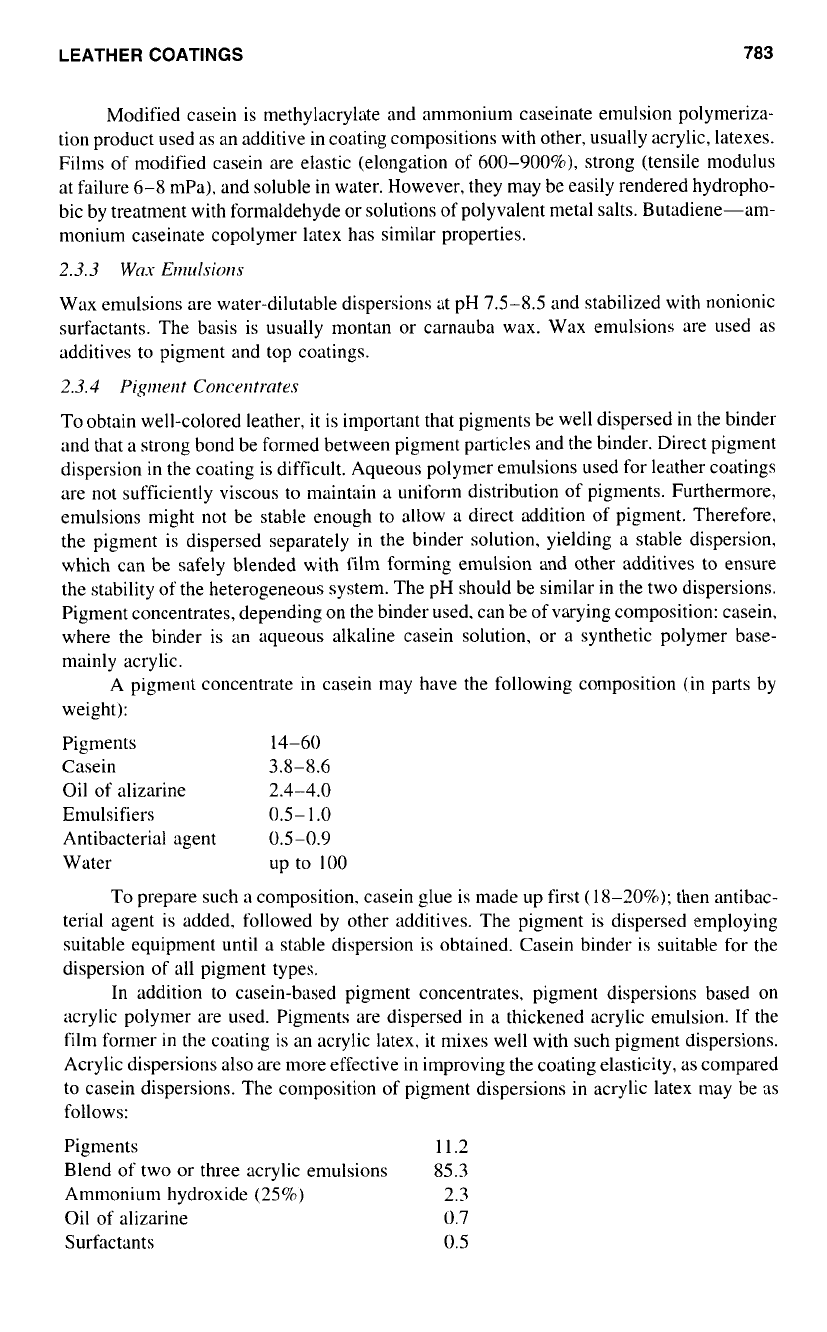
LEATHER COATINGS
783
Modified casein is methylacrylate and ammonium caseinate emulsion polymeriza-
tion product used
as
an additive
in
coating compositions with other, usually acrylic, latexes.
Films of modified casein are elastic (elongation of 600-900%), strong (tensile modulus
at failure 6-8 mPa), and soluble in water. However, they may be easily rendered hydropho-
bic by treatment with formaldehyde or solutions
of
polyvalent metal salts. Butadiene-am-
monium caseinate copolymer latex has similar properties.
2.3.3
Wos
E1~1~11.siorl.s
Wax emulsions are water-dilutable dispersions at pH
7.5-8.5
and stabilized with nonionic
surfactants. The basis is usually montan or carnauba wax. Wax emulsions are used as
additives to pigment and top coatings.
2.3.4
Pigr?lent
Cor~crr~trntrs
To obtain well-colored leather,
it
is important that pigments be well dispersed
in
the binder
and that a strong bond be formed between pigment particles and the binder. Direct pigment
dispersion
in
the coating is difficult. Aqueous polymer emulsions used for leather coatings
are not sufficiently viscous to maintain
a
uniform distribution of pigments. Furthermore,
emulsions might not be stable enough
to
allow a direct addition
of
pigment. Therefore,
the pigment is dispersed separately in the binder solution, yielding a stable dispersion,
which can be safely blended with film forming emulsion and other additives to ensure
the stability of the heterogeneous system. The pH should be similar in the two dispersions.
Pigment concentrates, depending
on
the binder used. can be of varying composition: casein,
where the binder is an aqueous alkaline casein solution, or a synthetic polymer base-
mainly acrylic.
A pigment concentrate in casein may have the following composition (in parts by
weight):
Pigments
14-60
Casein
3.8-8.6
Oil
of
alizarine 2.4-4.0
Emulsifiers
0.5-
1
.o
Antibacterial agent
0.5-0.9
Water up to
100
To prepare such
a
composition, casein glue is made up first
(18-20%);
then antibac-
terial agent
is
added. followed by other additives. The pigment is dispersed employing
suitable equipment until a stable dispersion is obtained. Casein binder is suitable for the
dispersion
of
all pigment types.
In addition to casein-based pigment concentrates, pigment dispersions based on
acrylic polymer are used. Pigments are dispersed in
a
thickened acrylic emulsion. If the
film former in the coating is an acrylic latex.
it
mixes well with such pigment dispersions.
Acrylic dispersions also are more effective
in
improving the coating elasticity, as compared
to casein dispersions. The composition of pigment dispersions in acrylic latex may be as
follows:
Pigments
11.2
Blend of two or three acrylic emulsions
85.3
Ammonium hydroxide
(25%)
2.3
Oil of alizarine
0.7
Surfactants
0.5
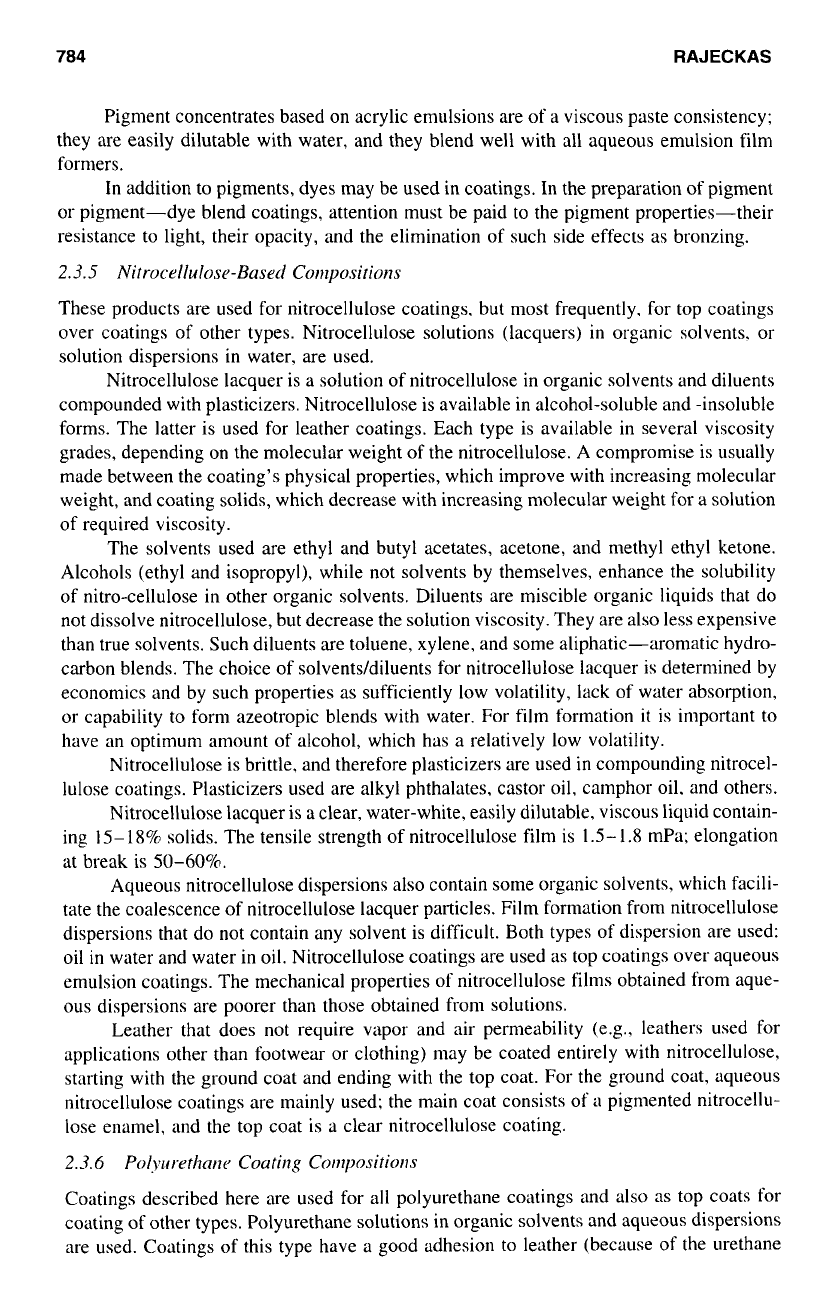
784
RAJECKAS
Pigment concentrates based on acrylic emulsions are of a viscous paste consistency;
they are easily dilutable with water, and they blend well with all aqueous emulsion film
formers.
In
addition to pigments, dyes may be used in coatings. In the preparation
of
pigment
or pigment-dye blend coatings, attention must be paid to the pigment properties-their
resistance to light, their opacity, and the elimination of such side effects
as
bronzing.
2.3.5
Nitrocellulos~-Base~i Contpositions
These products are used for nitrocellulose coatings. but most frequently. for top coatings
over coatings
of
other types. Nitrocellulose solutions (lacquers) in organic solvents. or
solution dispersions
in
water, are used.
Nitrocellulose lacquer is a solution of nitrocellulose in organic solvents and diluents
compounded with plasticizers. Nitrocellulose is available in alcohol-soluble and -insoluble
forms. The latter is used for leather coatings. Each type is available in several viscosity
grades, depending on the molecular weight
of
the nitrocellulose. A compromise is usually
made between the coating’s physical properties, which improve with increasing molecular
weight, and coating solids, which decrease with increasing molecular weight for a solution
of required viscosity.
The solvents used are ethyl and butyl acetates, acetone, and methyl ethyl ketone.
Alcohols (ethyl and isopropyl), while not solvents by themselves, enhance the solubility
of nitro-cellulose in other organic solvents. Diluents are miscible organic liquids that do
not dissolve nitrocellulose, but decrease the solution viscosity. They are also less expensive
than true solvents. Such diluents are toluene, xylene, and some aliphatic-aromatic hydro-
carbon blends. The choice
of
solvents/diluents for nitrocellulose lacquer is determined by
economics and by such properties as sufficiently low volatility, lack of water absorption,
or capability
to
form azeotropic blends with water. For film formation
it
is important
to
have an optimum amount of alcohol, which has a relatively low volatility.
Nitrocellulose is brittle, and therefore plasticizers are used
in
compounding nitrocel-
lulose coatings. Plasticizers used are alkyl phthalates, castor oil, camphor oil. and others.
Nitrocellulose lacquer is a clear, water-white. easily dilutable, viscous liquid contain-
ing
15-
18%
solids. The tensile strength of nitrocellulose film is
l
S-
I
.8
mPa; elongation
at break is
50-60%.
Aqueous nitrocellulose dispersions also contain some organic solvents. which facili-
tate the coalescence of nitrocellulose lacquer particles. Film formation from nitrocellulose
dispersions that do not contain any solvent is difficult. Both types
of
dispersion are used:
oil
in
water and water in oil. Nitrocellulose coatings are used as top coatings over aqueous
emulsion coatings. The mechanical properties of nitrocellulose films obtained from aque-
ous dispersions are poorer than those obtained from solutions.
Leather that does not require vapor and air permeability (e.g.. leathers used for
applications other than footwear or clothing) may be coated entirely with nitrocellulose.
starting with the ground coat and ending with the top coat. For the ground coat, aqueous
nitrocellulose coatings are mainly used; the main coat consists
of
a
pigmented nitrocellu-
lose enamel, and the top coat is a clear nitrocellulose coating.
2.3.6
Polyurethcrno Coating Compositions
Coatings described here are used for all polyurethane coatings and ah as top Coats for
coating of other types. Polyurethane solutions in organic solvents and aqueous dispersions
are used. Coatings
of
this type have a good adhesion
to
leather (because
of
the urethane
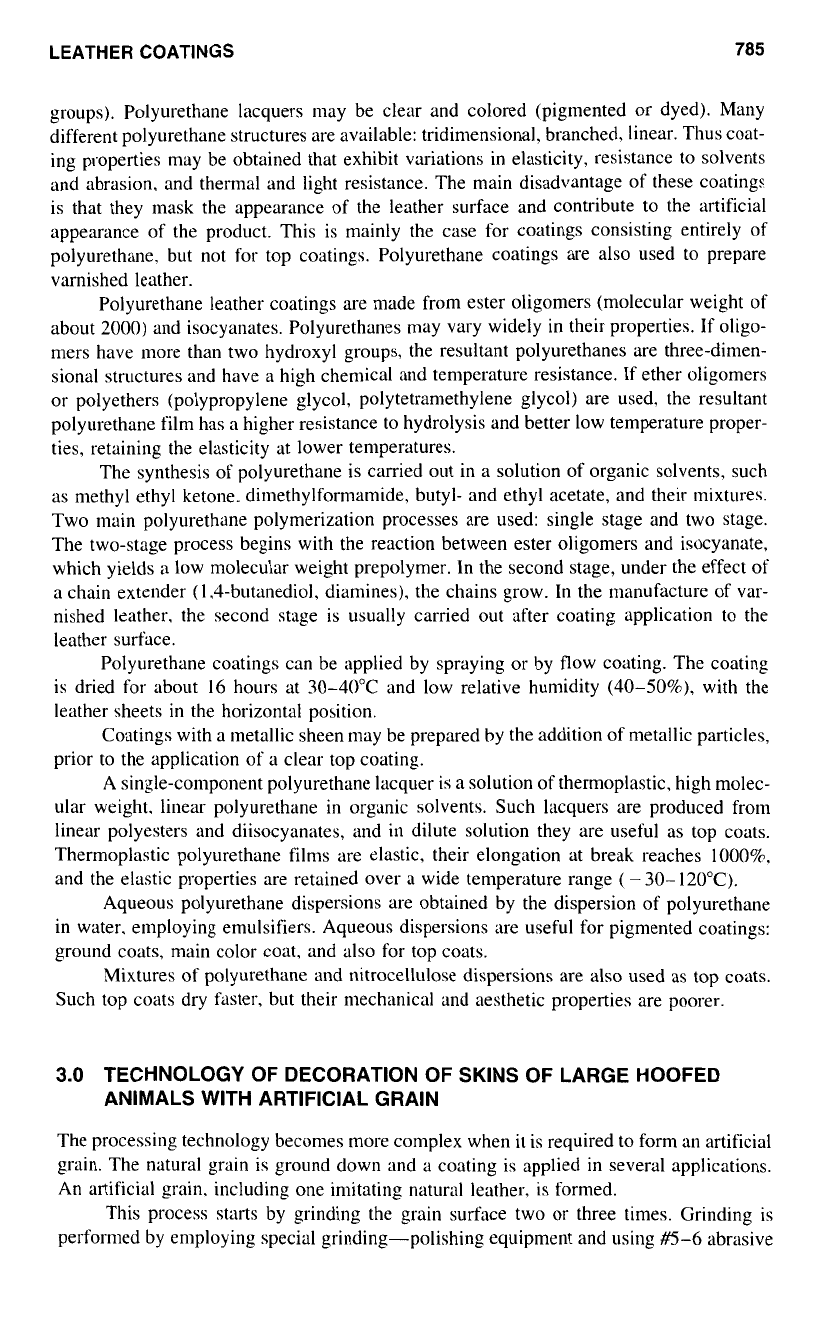
LEATHER COATINGS
785
groups). Polyurethane lacquers may be clear and colored (pigmented or dyed). Many
different polyurethane structures are available: tridimensional, branched. linear. Thus coat-
ing properties may be obtained that exhibit variations in elasticity, resistance
to
solvents
and abrasion. and thermal and light resistance. The main disadvantage of these coatings
is that they Inask the appearance of the leather surface and contribute
to
the artificial
appearance
of
the product. This is mainly the case for coatings consisting entirely
of
polyurethane. but not for top coatings. Polyurethane coatings are also used
to
prepare
varnished leather.
Polyurethane leather coatings are made from ester oligomers (molecular weight of
about
2000)
and isocyanates. Polyurethanes may vary widely in their properties. If oligo-
mers have more than two hydroxyl groups, the resultant polyurethanes are three-dimen-
sional structures and have
a
high chemical and temperature resistance.
If
ether oligomers
or polyethers (polypropylene glycol, polytetranlethylene glycol) are used, the resultant
polyurethane film has
a
higher resistance to hydrolysis and better low temperature proper-
ties, retaining the elasticity at lower temperatures.
The synthesis of polyurethane is carried
out
in
a
solution of organic solvents, such
as methyl ethyl ketone. dirnethylformamide, butyl- and ethyl acetate, and their mixtures.
Two main polyurethane polymerization processes are used: single stage and two stage.
The two-stage process begins with the reaction between ester oligomers and isocyanate,
which yields
a
low molecular weight prepolymer. In the second stage, under the effect
of
a
chain extender (1.4-butanediol, diamines). the chains grow. In the manufacture
of
var-
nished leather. the second stage is usually carried out after coating application to the
leather surface.
Polyurethane coatings can be applied by spraying or by flow coating. The coating
is dried for about
16
hours at 30-40°C and low relative humidity (40-50%), with the
leather sheets
in
the horizontal position.
Coatings with
a
metallic sheen may be prepared by the addition
of
metallic particles,
prior to the application of a clear top coating.
A single-component polyurethane lacquer is a solution of thermoplastic, high molec-
ular weight. linear polyurethane
in
organic solvents. Such lacquers are produced from
linear polyesters and diisocyanates, and in dilute solution they are useful as top coats.
Thermoplastic polyurethane films are elastic, their elongation at break reaches 1000~,
and the elastic properties are retained over
a
wide temperature range
(
-
30-
120°C).
Aqueous polyurethane dispersions are obtained by the dispersion of polyurethane
in water. employing emulsifiers. Aqueous dispersions are useful for pigmented coatings:
ground coats, main color coat, and also for top coats.
Mixtures
of
polyurethane and nitrocellulose dispersions are also used as top coats.
Such top coats dry faster, but their mechanical and aesthetic properties are poorer.
3.0
TECHNOLOGY OF DECORATION
OF
SKINS OF LARGE HOOFED
ANIMALS WITH ARTIFICIAL GRAIN
The processing technology becomes more complex when
it
is required
to
form an artificial
grain. The natural grain is ground down and a coating is applied
in
several applications.
An artificial grain. including one imitating natural leather, is formed.
This process starts by grinding the grain surface two or three times. Grinding is
performed by employing special grinding-polishing equipment and using
#-6
abrasive
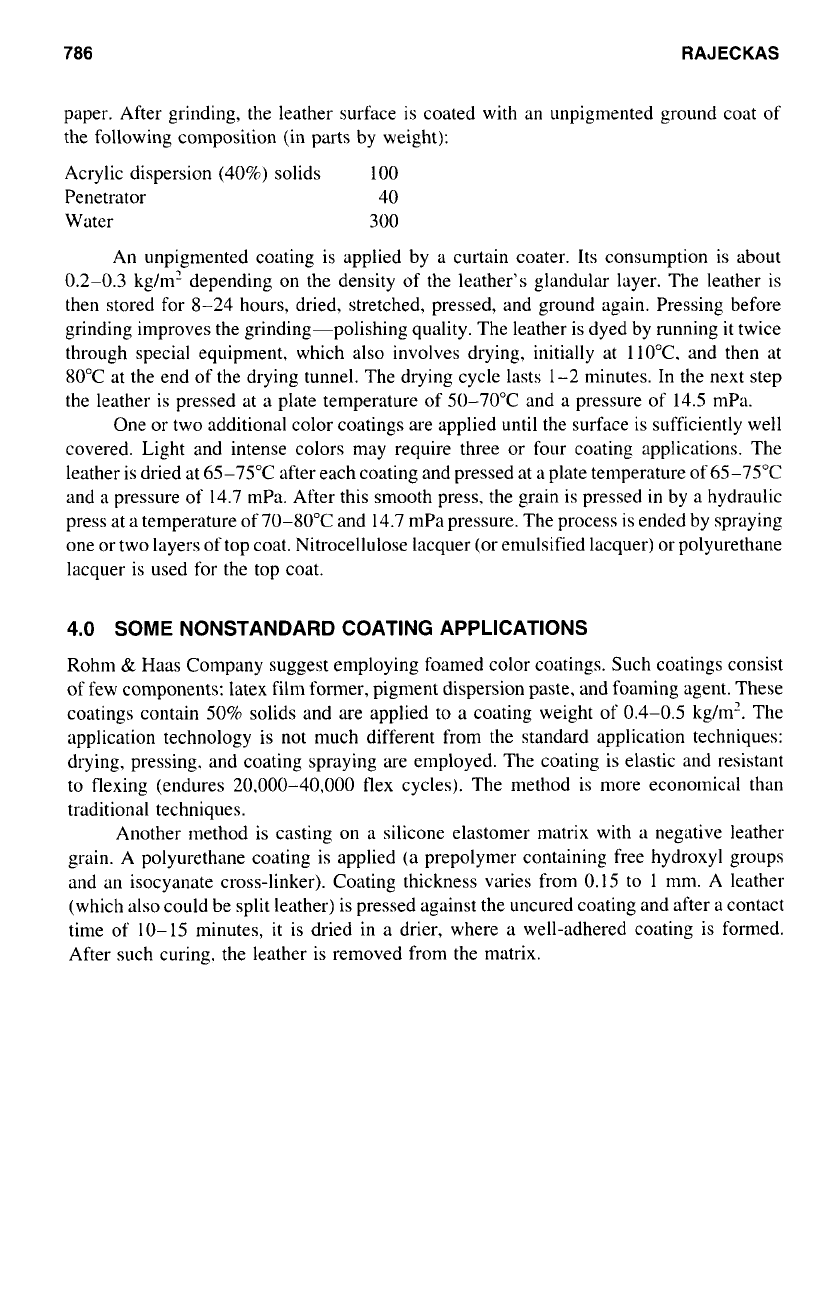
786
RAJECKAS
paper. After grinding, the leather surface is coated with an unpigmented ground coat of
the following composition (in parts by weight):
Acrylic dispersion (40%) solids
100
Penetrator 40
Water 300
An unpigmented coating is applied by a curtain coater. Its consumption is about
0.2-0.3 kgh’ depending
on
the density
of
the leather’s glandular layer. The leather is
then stored for 8-24 hours, dried. stretched. pressed, and ground again. Pressing before
grinding improves the grinding-polishing quality. The leather is dyed by running
it
twice
through special equipment, which also involves drying, initially at 110°C. and then at
80°C at the end of the drying tunnel. The drying cycle lasts 1-2 minutes. In the next step
the leather is pressed at
a
plate temperature of 50-70°C and a pressure of 14.5 mPa.
One or two additional color coatings are applied until the surface is sufficiently well
covered. Light and intense colors may require three or four coating applications. The
leather is dried at 65-75°C after each coating and pressed at a plate temperature of65-75°C
and a pressure of 14.7 mPa. After this smooth press. the grain is pressed in by a hydraulic
press at a temperature of 70-80°C and 14.7 mPa pressure. The process is ended by spraying
one or two layers of top coat. Nitrocellulose lacquer (or emulsified lacquer) or polyurethane
lacquer is used for the top coat.
4.0
SOME
NONSTANDARD COATING APPLICATIONS
Rohm
&
Haas Company suggest employing foamed color coatings. Such coatings consist
of
few components: latex film former, pigment dispersion paste, and foaming agent. These
coatings contain 50% solids and are applied
to
a coating weight of 0.4-0.5 kg/m’. The
application technology is not much different from the standard application techniques:
drying, pressing. and coating spraying are employed. The coating is elastic and resistant
to flexing (endures 20,000-40,000 tlex cycles). The method is more economical than
traditional techniques.
Another method is casting
on
a silicone elastomer matrix with
a
negative leather
grain. A polyurethane coating is applied (a prepolymer containing free hydroxyl groups
and an isocyanate cross-linker). Coating thickness varies from 0.15 to
1
mm. A leather
(which also could be split leather) is pressed against the uncured coating and after a contact
time of
IO-
15
minutes, it is dried in a drier, where a well-adhered coating is formed.
After such curing. the leather is removed from the matrix.
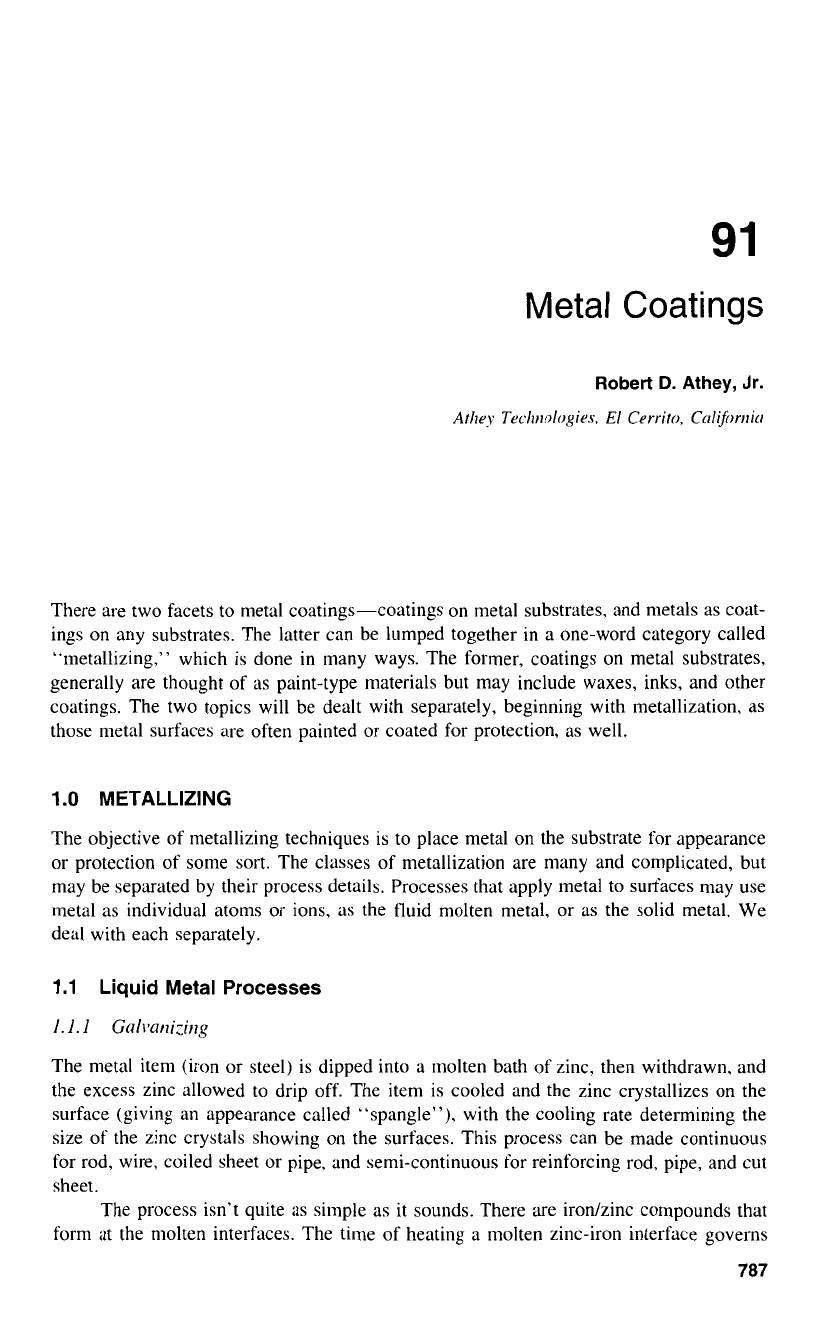
Metal
Coatings
There are two facets
to
metal coatings-coatings on metal substrates. and metals as coat-
ings on any substrates. The latter can be lumped together in a one-word category called
“metallizing,” which is done in many ways. The former, coatings on metal substrates,
generally are thought of as paint-type materials but may include waxes, inks, and other
coatings. The two topics will be dealt with separately, beginning with metallization, as
those metal surfaces are often painted or coated for protection, as well.
1
.O
METALLIZING
The objective
of
metallizing techniques is to place metal on the substrate for appearance
or protection of some sort. The classes
of
metallization are many and complicated, but
may be separated by their process details. Processes that apply metal to surfaces may use
metal
as
individual atoms or ions, as the fluid molten metal, or as the solid metal. We
deal with each separately.
1.1
Liquid Metal Processes
1.
I.
1
Gnlvani:ing
The metal item (iron or steel) is dipped into a molten bath of zinc. then withdrawn, and
the excess zinc allowed to drip off. The item is cooled and the zinc crystallizes on the
surface (giving an appearance called “spangle”). with the cooling rate determining the
size of the zinc crystals showing
on
the surfaces. This process can be made continuous
for rod, wire, coiled sheet or pipe, and semi-continuous for reinforcing rod, pipe, and cut
sheet.
The process isn’t quite
as
simple as it sounds. There are irodzinc compounds that
form at the molten interfaces. The time
of
heating a molten zinc-iron interface governs
787
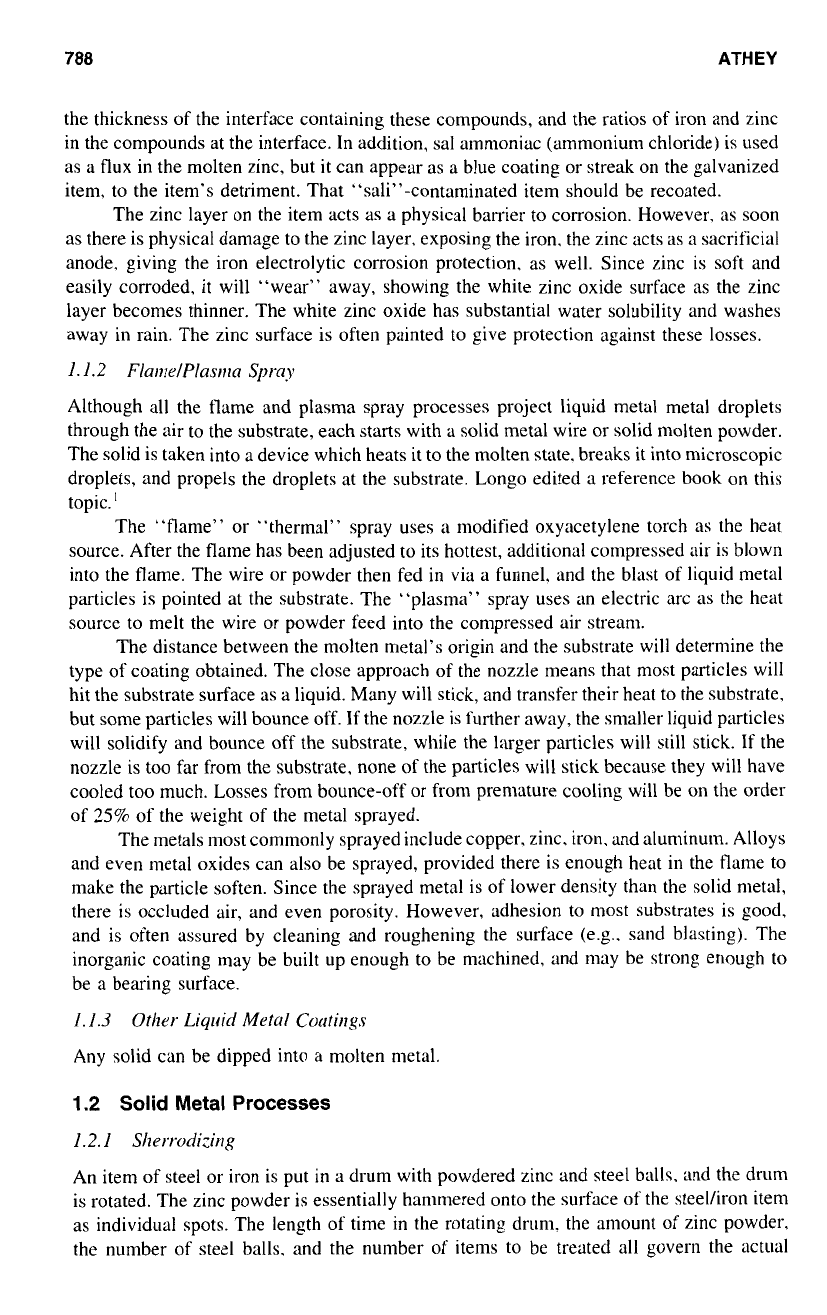
788
ATHEY
the thickness of the interface containing these compounds, and the ratios
of
iron and zinc
in the compounds at the interface. In addition, sal ammoniac (ammonium chloride) is used
as a flux in the molten zinc, but
it
can appear as a blue coating or streak on the galvanized
item, to the item’s detriment. That “sali”-contaminated item should be recoated.
The zinc layer on the item acts as a physical barrier
to
corrosion. However. as soon
as there is physical damage to the zinc layer, exposing the iron. the zinc acts as a sacrificial
anode. giving the iron electrolytic corrosion protection. as well. Since zinc is soft and
easily corroded,
it
will “wear” away, showing the white zinc oxide surface as the zinc
layer becomes thinner. The white zinc oxide has substantial water solubility and washes
away in rain. The zinc surface is often painted to give protection against these losses.
1.1.2
FlandPla.srnn
Spray
Although all the flame and plasma spray processes project liquid metal metal droplets
through the air to the substrate, each starts with a solid metal wire or solid molten powder.
The solid is taken into a device which heats it to the molten state. breaks it into microscopic
droplets, and propels the droplets at the substrate. Longo edited a reference book on this
topic.
‘
The “flame” or “thermal” spray uses a modified oxyacetylene torch as the heat
source. After the flame has been adjusted to its hottest, additional compressed air is blown
into the flame. The wire or powder then fed
in
via a funnel. and the blast of liquid metal
particles is pointed at the substrate. The “plasma” spray uses an electric arc
as
the heat
source to melt the wire or powder feed into the compressed air stream.
The distance between the molten metal’s origin and the substrate will determine the
type of coating obtained. The close approach
of
the nozzle means that most particles will
hit the substrate surface as a liquid. Many will stick, and transfer their heat to the substrate.
but some particles will bounce off. If the nozzle is further away, the smaller liquid particles
will solidify and bounce off the substrate, while the larger particles will still stick. If the
nozzle is
too
far from the substrate, none of the particles will stick because they will have
cooled too much. Losses from bounce-off or from premature cooling will be on the order
of
25%
of the weight of the metal sprayed.
The metals most commonly sprayed include copper, zinc. iron. and aluminum. Alloys
and even metal oxides can also be sprayed, provided there is enough heat in the flame to
make the particle soften. Since the sprayed metal is of lower density than the solid metal,
there is occluded air, and even porosity. However, adhesion to most substrates is good,
and is often assured by cleaning and roughening the surface (e.g.. sand blasting). The
inorganic coating may be built up enough
to
be machined, and may be strong enough
to
be a bearing surface.
l.
1.3
Other
Liquid
Metul
Cocrtirlgs
Any solid can be dipped into a molten metal.
1.2
Solid
Metal
Processes
1.2.1
Skerrodizirlg
An item of steel or iron is put
in
a drum with powdered zinc and steel balls. and the drum
is rotated. The zinc powder is essentially hammered onto the surface
of
the steel/iron item
as individual spots. The length of time
in
the rotating drum. the amount of zinc powder.
the number of steel balls, and the number of items to be treated all govern the acttlal
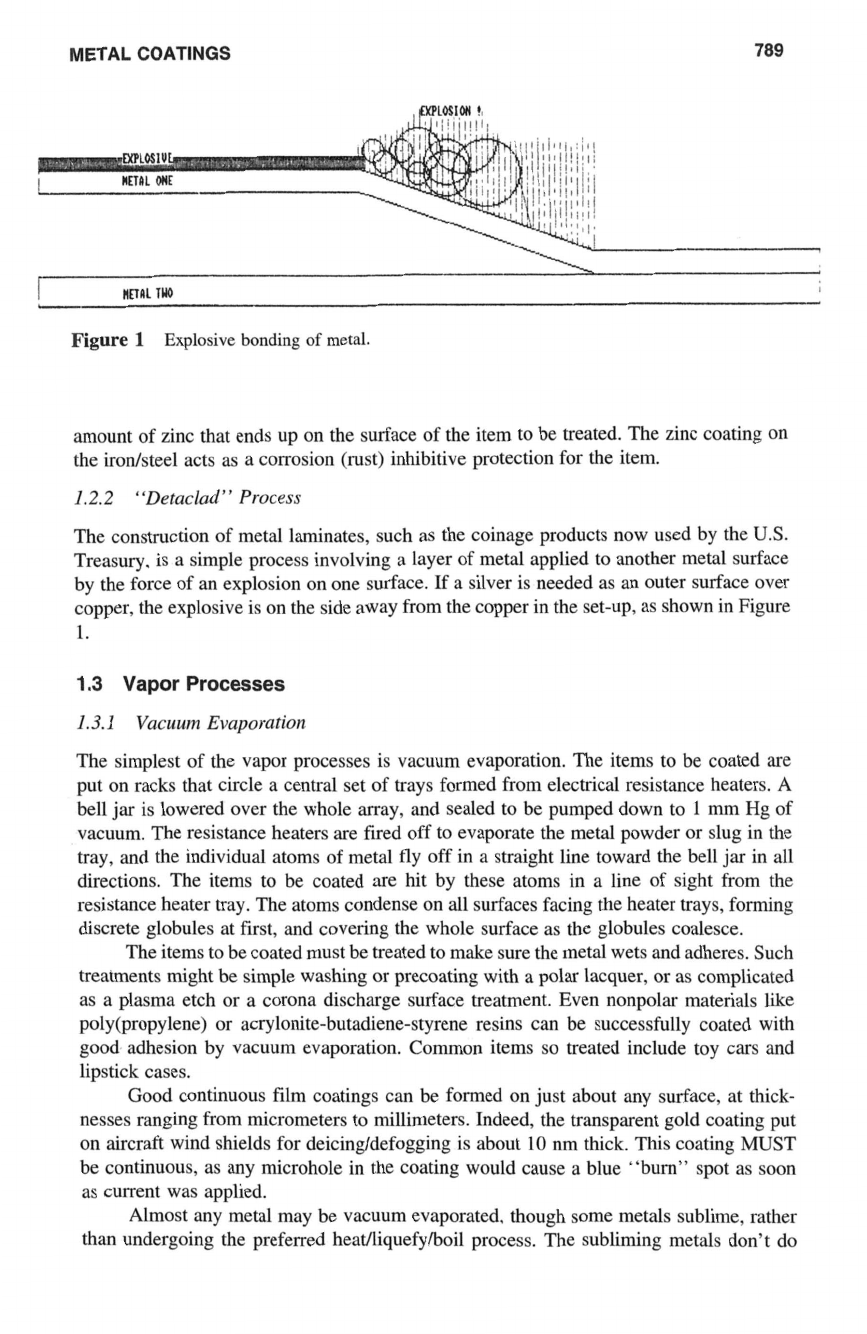
METAL COATINGS
789
Figure
1
Explosive
bonding
of
metal.
amount of zinc that ends up on the surface of the item to be treated. The zinc coating on
the iron/steel acts as a corrosion (rust) inhibitive protection for the item.
1.2.2
“Detaclad” Process
The construction of metal laminates, such as the coinage products now used by the
U.S.
Treasury. is a simple process involving a layer of metal applied to another metal surface
by the force of an explosion on one surface. If a silver is needed as an outer surface over
copper, the explosive is on the side away from the copper in the set-up, as shown in Figure
l.
1.3
Vapor
Processes
1.3.1
Vacuum Evaporation
The simplest of the vapor processes is vacuum evaporation. The items to be coated are
put on racks that circle a central set of trays formed from electrical resistance heaters. A
bell jar is lowered over the whole array, and sealed to be pumped down to
1
mm
Hg of
vacuum. The resistance heaters are fired off to evaporate the metal powder
or
slug in the
tray, and the individual atoms of metal fly off in a straight line toward the bell jar in all
directions. The items to be coated are hit by these atoms in a line of sight from the
resistance heater tray. The atoms condense on all surfaces facing the heater trays, forming
discrete globules at first, and covering the whole surface as the globules coalesce.
The items to be coated must be treated to make sure the metal wets and adheres. Such
treatments might be simple washing
or
precoating with a polar lacquer,
or
as complicated
as a plasma etch
or
a corona discharge surface treatment. Even nonpolar materials like
poly(propy1ene)
or
acrylonite-butadiene-styrene
resins can be successfully coated with
good adhesion by vacuum evaporation. Common items
so
treated include toy cars and
lipstick cases.
Good continuous film coatings can be formed on just about any surface, at thick-
nesses ranging from micrometers to millimeters. Indeed, the transparent gold coating put
on aircraft wind shields for deicinddefogging is about
10
nm thick. This coating
MUST
be continuous, as any microhole in the coating would cause a blue “burn” spot as soon
as current was applied.
Almost any metal may be vacuum evaporated. though some metals sublime, rather
than undergoing the preferred heatniquefyhoil process. The subliming metals don’t do
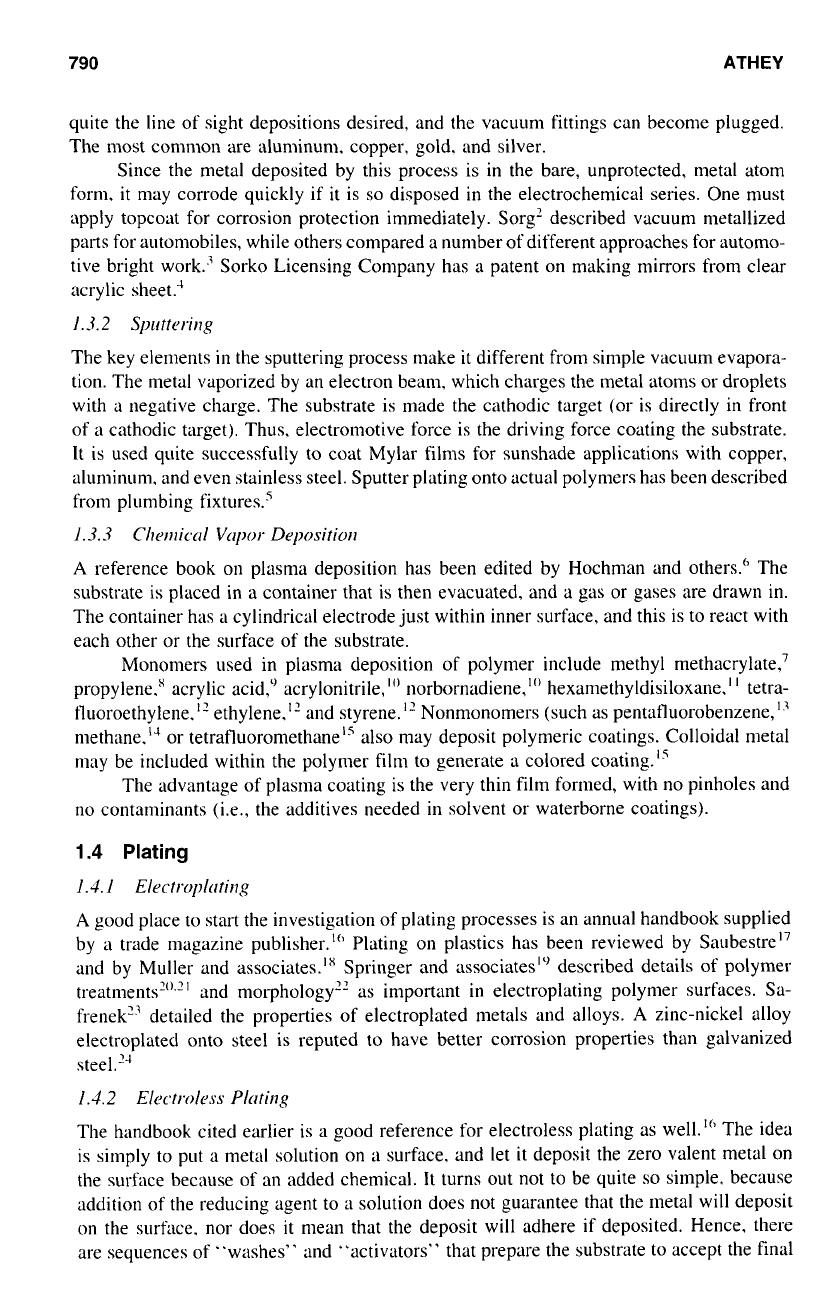
790
ATHEY
quite the line of sight depositions desired, and the vacuum fittings can become plugged.
The most common are aluminum. copper, gold. and silver.
Since the metal deposited by this process is in the bare, unprotected, metal atom
form,
it
may corrode quickly if
it
is
so
disposed in the electrochemical series. One must
apply topcoat for corrosion protection immediately. Sorg' described vacuum metallized
parts for automobiles, while others compared a number
of
different approaches for automo-
tive bright w0rk.j Sorko Licensing Company has a patent on making mirrors from clear
acrylic sheet.'
1.3.2 Sprtterirlg
The key elements
in
the sputtering process make it different from simple vacuum evapora-
tion. The metal vaporized by an electron beam, which charges the metal atoms or droplets
with a negative charge. The substrate is made the cathodic target (or is directly in front
of
a
cathodic target). Thus. electromotive force is the driving force coating the substrate.
It is used quite successfully to coat Mylar films for sunshade applications with copper,
aluminum. and even stainless steel. Sputter plating
onto
actual polymers has been described
from plumbing fixtures.'
1.3.3
Cherniccrl Vcpw Depositiorl
A
reference book
on
plasma deposition has been edited by Hochman and others." The
substrate is placed in
a
container that is then evacuated, and a gas or gases are drawn in.
The container has
a
cylindrical electrode just within inner surface, and this is to react with
each other or the surface of the substrate.
Monomers used in plasma deposition
of
polymer include methyl methacrylate,'
propylene.s acrylic acid,') acrylonitrile,'" norbornadiene,'" hexamethyldisiloxane." tetra-
tluoroethylene." ethylene." and styrene." Nonmonomers (such as pentafluorobenzene,'"
methane.14 or tetrafluoromethane" also may deposit polymeric coatings. Colloidal metal
may be included within the polymer film to generate a colored coatingi5
The advantage
of
plasma coating is the very thin film formed, with no pinholes and
no
contaminants (i.e., the additives needed in solvent
or
waterborne coatings).
1.4
Plating
1.4.
l
Electropltrting
A
good place to start the investigation
of
plating processes
is
an annual handbook supplied
by
a
trade magazine publisher."' Plating
on
plastics has been reviewed by Sa~bestre'~
and by Muller and associates.Ix Springer and associates'" described details
of
polymer
treatments"'.'' and morphology" as important
in
electroplating polymer surfaces. Sa-
frenek" detailed the properties
of
electroplated metals and alloys.
A
zinc-nickel alloy
electroplated onto steel is reputed to have better corrosion properties than galvanized
steel.'4
1.3.2 Electlvltss Plrrtirlg
The handbook cited earlier is
a
good reference for electroless plating as well.'" The idea
is simply to put a metal solution on a surface. and let
it
deposit the zero valent metal on
the surface because of an added chemical. It turns out not to be quite
so
simple. because
addition of the reducing agent to a solution does
not
guarantee that the metal will deposit
on
the surface. nor does
it
mean that the deposit will adhere
if
deposited. Hence, there
are sequences of "washes" and "activators" that prepare the substrate
to
accept the final
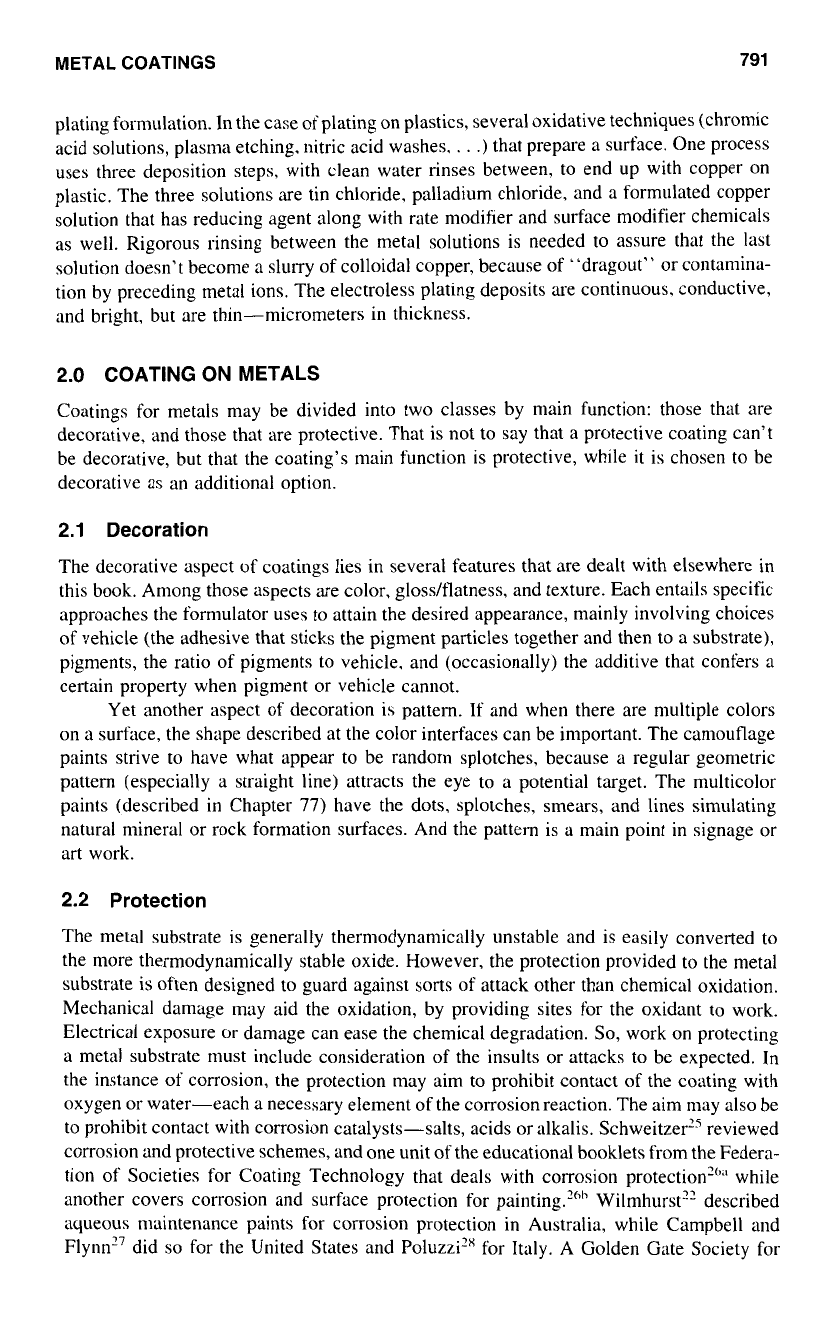
METAL COATINGS
791
plating formulation. In the case of plating on plastics, several oxidative techniques (chromic
acid solutions, plasma etching. nitric acid washes,
.
.
.)
that prepare a surface. One process
uses three deposition steps, with clean water rinses between, to end up with copper on
plastic. The three solutions are tin chloride, palladium chloride, and a formulated copper
solution that has reducing agent along with rate modifier and surface modifier chemicals
as
well. Rigorous rinsing between the metal solutions is needed to assure that the last
solution doesn't become a slurry
of
colloidal copper, because
of
"dragout" or contamina-
tion by preceding metal ions. The electroless plating deposits are continuous. conductive,
and bright, but are thin-micrometers in thickness.
2.0
COATING
ON
METALS
Coatings for metals may be divided into two classes by main function: those that are
decorative, and those that are protective. That is not to say that a protective coating can't
be decorative, but that the coating's main function is protective, while
it
is chosen
to
be
decorative as an additional option.
2.1
Decoration
The decorative aspect of coatings lies in several features that are dealt with elsewhere in
this book. Among those aspects are color, gloss/flatness, and texture. Each entails specific
approaches the formulator uses to attain the desired appearance, mainly involving choices
of vehicle (the adhesive that sticks the pigment particles together and then to a substrate),
pigments, the ratio of pigments to vehicle. and (occasionally) the additive that confers a
certain property when pigment or vehicle cannot.
Yet another aspect
of
decoration is pattern. If and when there are multiple colors
on a surface, the shape described at the color interfaces can be important. The camouflage
paints strive to have what appear to be random splotches, because a regular geometric
pattern (especially a straight line) attracts the eye to a potential target. The multicolor
paints (described in Chapter
77)
have the dots, splotches, smears, and lines simulating
natural mineral or rock formation surfaces. And the pattern is a main point in signage or
art work.
2.2
Protection
The metal substrate is generally thermodynamically unstable and is easily converted
to
the more thermodynamically stable oxide. However, the protection provided
to
the metal
substrate is often designed to guard against sorts of attack other than chemical oxidation.
Mechanical damage may aid the oxidation, by providing sites for the oxidant to work.
Electrical exposure or damage can ease the chemical degradation.
So,
work
on
protecting
a metal substrate must include consideration
of
the insults or attacks to be expected.
In
the instance
of
corrosion, the protection may aim to prohibit contact
of
the coating with
oxygen or water-each a necessary element of the corrosion reaction. The aim may also be
to prohibit contact with corrosion catalysts-salts, acids or alkalis. Schweitzer" reviewed
corrosion and protective schemes, and one unit
of
the educational booklets from the Federa-
tion of Societies for Coating Technology that deals with corrosion protection""' while
another covers corrosion and surface protection for painting.'"" Wilmhurst" described
aqueous maintenance paints for corrosion protection in Australia, while Campbell and
Flynn"
did
so
for the United States and Poluzzi'x for Italy. A Golden Gate Society for
